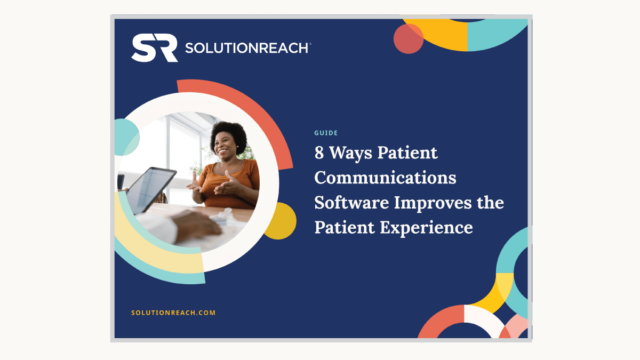Though access to quality care is essential for patients to improve health outcomes, patients themselves are increasingly taking on the responsibility for their own healthcare. As a result, several factors play into patients’ ability to optimize their care opportunities. One of these is patient activation levels, a person’s understanding, competence, and ability to participate in care decisions and processes.
Your healthcare practice can also play a key role in encouraging and promoting levels of activation when prioritized in your office’s patient engagement strategy. A 2022 survey found that 61% of patients wanted more engagement with their healthcare professionals. Your efforts can also reinforce to your patients how their buy-in on making positive behavioral changes can help them successfully manage their own health.
In this article, we’ll define patient activation, delineate what it is and what it is not, and review the many benefits it offers. We’ll also look at why patient activation is critical to an effective care cycle and what role your practice can play in engaging patients more effectively to promote greater activation and adherence to doctor-recommended care.
What is patient activation (and what is it not)?
As we said, patients must be engaged and activated to participate in their own care to get the most out of it. Medical researcher and professor Judith Hibbard explained how patient activation differs from patient engagement.
“Patient engagement emphasizes patients’ willingness and ability to take independent actions to manage their health and care,” she said. “Patient activation (equates) with understanding one’s role in the care process and having the knowledge, skill, and confidence to manage one’s health and healthcare.”
Patient engagement is an umbrella term that includes patient activation but refers to interventions providers make for patients to increase activation. It also includes measuring patients’ resulting behavior changes. Meanwhile, patient adherence is the active choice patients make in following through with prescribed treatment, and patient compliance is providers’ efforts to influence patients to follow specific medical advice and prescription medication instructions.
Why is patient activation important?
Now, let’s look at some reasons why patient activation is critical both for your patients and your medical practice. Your end goal here is to increase the activation rate of as many members of your patient pool as possible.
Highly activated patients:
1. Are More Likely to Engage in Positive Health Behaviors and Experience Better Health Outcomes
Studies have shown that people who score higher on the Patient Activation Measure (PAM), a standardized activation measurement tool, are significantly more likely than people who score lower to engage in preventive care such as regular check-ups, screenings, and immunizations. More activated patients are also more likely to embrace healthy behaviors, such as getting regular exercise and eating a healthy diet, while avoiding unhealthy behaviors like smoking and illegal drug use.
Less activated patients are also 3x as likely to have unmet medical needs and 2x as likely to delay medical care.
2. Enjoy a Better Patient Experience
Highly activated patients consistently report more positive care experiences, with higher quality interpersonal conversations and increased out-of-office contact with their care team, Hibbard said. They also report better patient care experiences from a given provider than do less activated patients who see the same practice.
3. Incur Lower Care Costs
One study found that after controlling for demographics and health status, activated patients cost nearly $2,000 less per patient annually than less activated patients.
How can I encourage greater patient activation?
You can help your patients become more activated through:
- Better, more personalized patient-provider communication
- Developing strong patient education and health literacy skills
- Leveraging technology to improve patient outreach efforts
You can apply the PAM metric to help each patient understand and act upon these activation truths:
- Believe that they are ultimately responsible for their own health
- Possess the confidence and knowledge to manage their health
- Proactively take action to maintain and improve their health
- Stay the course even when experiencing stress
More specifically, consider adopting these four key activation strategies as part of your office’s patient engagement plan:
1. Arm patients with relevant health education and literacy information
You’ll want to share pertinent health information and resources with patients to give them the knowledge and facts to make informed decisions. Whether through a targeted patient education newsletter or specific materials and resource links texted or emailed to a patient, your efforts to bring patients up to speed on health issues that impact them can help them improve their choices and behaviors.
2. Ongoing patient support outside the office
Sending targeted text messages and emails allows your practice to stay top of mind with each patient. These communications also help remind patients to schedule needed care as well as recommended preventive visits. Texts and emails are also a great way to engage with patients after their appointment to ensure they understand and are adhering to care instructions and medication directions. Research shows that patients receiving a provider text message saw a 41% decline in their risk for 30-day hospital readmission.
3. Engage patients in shared decision-making
Ensure patients fully understand their diagnoses, are aware of their treatment options, and know where they can easily access more information. Fully explain lab results, offer further care recommendations, and let them know who to contact with follow-up questions. When doctor-advised procedures or treatments may be cost-prohibitive, offer patients flexible payment options that can help them gain greater access and inform their decision-making.
4. Balance provider/staff interpersonal skills with automated patient technology
Since many of your important patient messages are repetitive and time-consuming, expand your reach and minimize your admin team’s manual workload with automated patient communications software. Timely appointment reminders, recall notifications, patient education newsletters, and patient surveys can automatically be sent via personalized texts and emails to help patients better manage their own care. These solutions free your patients up from worrying about when to book their next appointment or schedule a routine preventive visit. Automation enables you and your staff members to interact more consistently and frequently with your patients to support higher activation rates.
Key Takeaways
While the onus is surely on patients to ensure they get needed healthcare, your practice can increase patient activation rates through more active engagement. Embracing proven patient engagement best practices helps your patients be more involved with and proactive about managing their own care. By adopting these strategies, your practice can better assist patients in unlocking their full potential to make more informed decisions and take control of their own health.

Learn more about how you can ensure your patients enjoy a more streamlined and effortless care journey, download the guide, “8 Ways Patient Communications Software Improves the Patient Experience”.
Read the Guide


